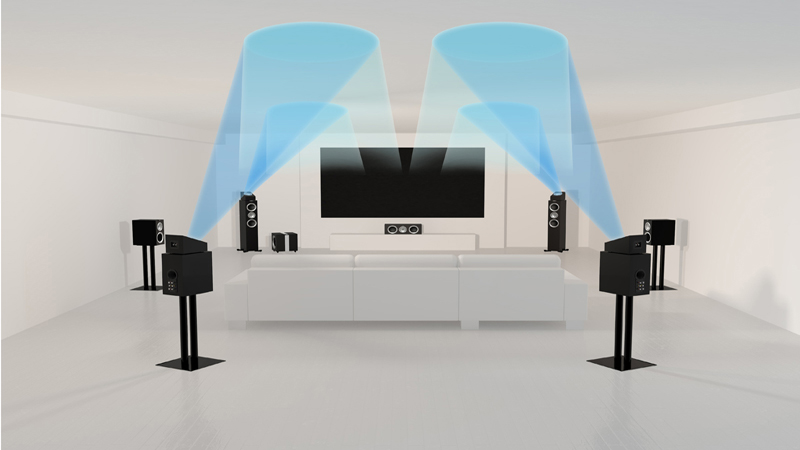
If you haven’t heard the news yet, there’s a brand-new iPhone coming this year that will sport dual cameras with an ultra-wide lens, a 6.1-inch Liquid Retina display and, for audio fans, spatial audio support through Dolby Atmos.
For some, this will be their first introduction to the world beyond traditional surround sound where there’s very few limits on the number of channels and every sound becomes mapped to a location in space (hence the name spatial audio).
For others, especially folks who follow the TV tech space, however, neither spatial audio or Dolby Atmos are new. In fact, we’ve had them for the last five years now in various forms, and they’ve radically changed things for the better.
So why aren’t we overly optimistic about Atmos coming to iPhone 11? Here’s why.
What is spatial audio? What is Dolby Atmos?
Before we can talk about the limitations of spatial audio, we should probably explain what that term means and how Dolby - one of the most famous sound technology companies in the entire world - factors into it. (Feel free to skip this if you know about Atmos already and just jump to the next section.)
If you have no idea what Atmos is all about, imagine two speakers sitting next to a TV. If connected through a receiver that’s passing audio signal from the TV, these speakers will be playing in stereo (i.e. two-channel) sound, where all sounds either come out of the left or the right speaker. Now, imagine we have a five-channel setup where sound comes not only from left and right speakers, but also a new center channel and two rear speakers that add some depth to the sound.
If you can picture what surround sound looks and sounds like, you can imagine Atmos. It’s like having a room full of speakers that come from every different direction but only requires two (sometimes four) extra speakers that add height and depth to the sound. Instead of mapping audio to left, right or center, Atmos allows audio mixers can ‘place’ sounds in the room with the listener - a helicopter can sound like it’s hovering directly overhead, for example, rather than appearing to fly by you.
Sign up for breaking news, reviews, opinion, top tech deals, and more.

That last bit about Dolby Atmos requiring extra speakers to work is important and will likely be hotly contested by reviewers, influencers and even Dolby itself in the months to come - especially once the iPhone 11 comes out.
It’s worth mentioning that there are a number of spatial audio developers out there at the moment - DTS, Creative Labs and Sony all have their own formats / techniques for spatial audio - but really Atmos is leading the pack in terms of name recognition and support.
What will Atmos do on iPhone 11?
That’s kind of a tricky question. In theory, Dolby Atmos on iPhone 11 will offer a significant improvement to the way Apple’s phones have sounded in the past. Sound should be clearer and more dynamic, and dialogue should be clearer.
What Dolby says is that with Dolby Atmos on mobile phones “you’ll notice louder, clearer sound without speaker distortion or rattle for softer sounds like piano notes and quiet voices and for louder, more intense sounds like action movie explosions. Dialogue is automatically enhanced, volume is evened out, and you’ll hear virtualized, immersive audio for all your content.”
The company has certainly delivered that on other home entertainment products, but the question is if Apple and Dolby can do it with the iPhone 11. Let’s also not pretend that the iPhone 11 is the first to support Dolby Atmos Mobile - it’s supported on the Samsung Galaxy S9, Galaxy S10, Note9, Razer Phone, Oppo Reno, Sony Xperia 1, OnePlus 7 Pro and many others, all of which give us a good reference point of what it could sound like on the iPhone 11 when it comes out later this year.

Atmos and its limitations on phones
After hearing about all the things Atmos does with spatial audio, why aren’t we more excited about it? Well, unfortunately, because it’s not true Dolby Atmos - and without the proper overhead speakers, it’s probably not going to offer the best Atmos experience. It just won’t be possible using the iPhone’s smaller drivers and amp.
What we’re going to get is the Dolby Atmos Mobile experience that will be louder and clearer, but probably not offer the cool immersive audio we’ve heard on various Hi-Fi systems. What’s coming will be an improvement, to be sure, but it’s not going to live up to the Dolby Atmos experience so many of us love and enjoy at home.
The other edge of that sword, however, is that any innovation is better than no innovation at all. And while Atmos on iPhone might not live up to our lofty expectations and previous experiences with the technology, it's an exciting taste of what better audio sounds like for people who’ve never had the chance to sit in front of a full 7.1.4 setup.
- Here's your guide to the best Dolby Atmos speakers

Nick Pino is Managing Editor, TV and AV for TechRadar's sister site, Tom's Guide. Previously, he was the Senior Editor of Home Entertainment at TechRadar, covering TVs, headphones, speakers, video games, VR and streaming devices. He's also written for GamesRadar+, Official Xbox Magazine, PC Gamer and other outlets over the last decade, and he has a degree in computer science he's not using if anyone wants it.